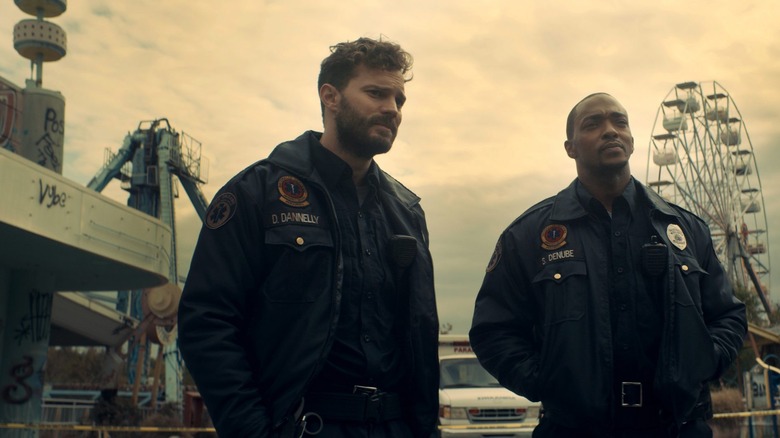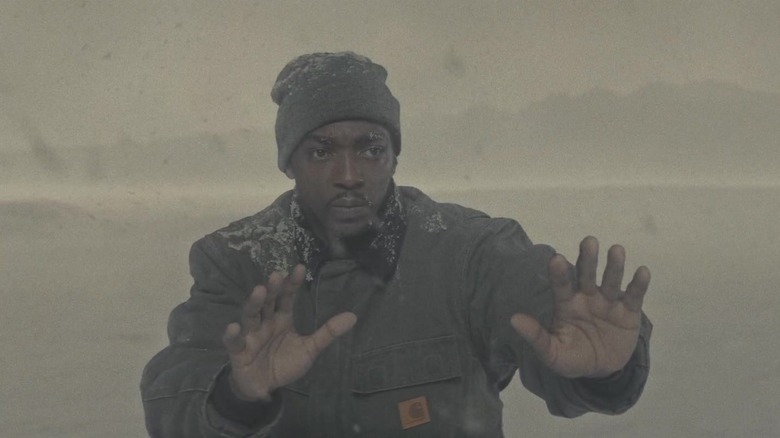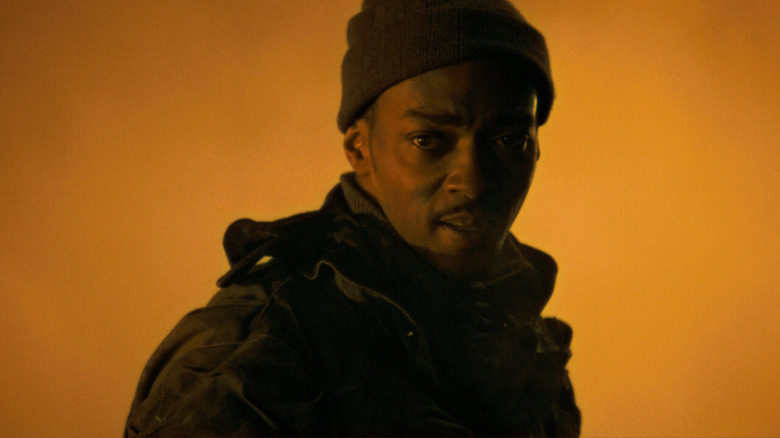Synchronic Ending Explained: Which Timeline Are You Experiencing?
Time travel movies are not easy to pull off, but the creative team of Justin Benson and Aaron Moorhead tackled the impossible with their 2019 science fiction drama "Synchronic." Set in New Orleans, "Synchronic" gets its name from a new designer drug infiltrating the market that allows users to time travel. When the film popped up on Netflix in 2020, its popularity spiked, and it topped the most-watched list for multiple days in a row. "Synchronic" stars Anthony Mackie ("The Falcon and the Winter Soldier," "The Hurt Locker") and Jamie Dornan ("Fifty Shades of Grey," "Barb and Star Go to Vista Del Mar") as best friends and paramedics Steve and Dennis tasked with investigating the aftermath of the drug's effects. The duo soon finds bodies that have been brutalized in unexplainable ways like being stabbed with ancient weapons, burned alive, or attacked by animals that no longer live in the area.
Everything intensifies when they learn Dennis' teenage daughter Brianna has taken the drug but has yet to appear back in the current timeline. Steve goes to a smoke shop and buys up the remaining stock of Synchronic, learning that the product has been discontinued. Later, he comes face to face with the chemist, who created the drug, who explains that Synchronic alters the pineal gland's perception of time. This allows users with non-calcified pineal glands (like teenagers) to easily pass through time. Adults, however, seem to move through time only partially like ghosts.
A Journey To Find Brianna
Steve discovers that he has a tumor on his pineal gland, and this weird "blessing in disguise" allows him to use his stock of Synchronic to track down Brianna. He records his observations after taking the drug, realizing that Synchronic allows the user to travel backwards through time for seven minutes in the same geographical location and that the location where the pill is taken determines the destination year. Unfortunately, certain time periods were far more hostile toward people who look like Steve, so his journey through time is dangerous — not just because he is taking designer drugs but also because he's winding up in eras like the ice age (which could also be the future at this rate) or the KKK-infested 1920s. Through his travels, however, he discovers that he can bring objects or people back — as long as he's making direct contact.
Steve eventually tells Dennis about his tumor and his plans to find Brianna. Once the two deduce her location by noticing the phrase "Allways" carved into a bolder where she used to sit in the park, Steve goes back in time to find her. The two reunite during the Battle of New Orleans in 1815. He gives Brianna his last Synchronic pill to escape, but a looter who believes Steve is a runaway slave intercepts them and threatens both of their lives. Steve distracts him to allow Brianna to get to the correct geographical spot to safely return home, but because he wasn't in direct contact, he is unable to return with her.
Did He Stay on Purpose?
Here's the beautiful thing about "Synchronic" (and all of the films of Benson and Moorhead): The ending is not ham-fisted or given to you on a silver platter. It may be frustrating to walk away from a film with an ambiguous idea of a character's intent, but in a film like "Synchronic," that's half the fun. There are so many details I've left out in this ending explainer, and whether or not they're vital to the ending is completely up to the viewer.
Justin Benson and Aaron Moorhead have been making films together since 2012's criminally underseen "Resolution," and every film they've made since then leaves audiences craving more and coming up with their own theories. Even in their romantic horror film "Spring," which arguably has one of their most definitive conclusions, there are a lot of different ways the ending can be analyzed or interpreted. "Resolution" was given something of a second pass with the partial sequel (depending on your interpretation) "The Endless," but you could still write a psychology textbook trying to decipher what it all means.
The films of Benson and Moorhead invite your interpretations, your feelings, and your perceptions to be active participants in the film's messaging, and there's no one else quite like them working today (I said what I said!). The duo have a new film premiering at Sundance this year called "Something In The Dirt" which deals with supernatural events in a Los Angeles apartment that pushes a pair of neighbors down a rabbit hole where they uncover the dangers of what they've witnessed, the city, and each other. If you're someone who liked "Synchronic" and are looking for more movies that challenge you to analyze what you've watched, do yourself a favor and track down Benson and Moorhead's other films.


